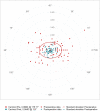Visual and Refractive Outcomes After Bilateral Implantation of a Biconvex Aspheric Toric Monofocal Intraocular with a Double C-Loop Haptic Design
- PMID: 37750099
- PMCID: PMC10518175
- DOI: 10.2147/OPTH.S432598
Visual and Refractive Outcomes After Bilateral Implantation of a Biconvex Aspheric Toric Monofocal Intraocular with a Double C-Loop Haptic Design
Abstract
Purpose: To show the visual and refractive outcomes in cataract patients with corneal astigmatism when bilaterally implanted with a biconvex aspheric toric monofocal intraocular lens (IOL) with a double C-loop haptic-design.
Methods: Forty-seven cataract patients (94 eyes) with corneal astigmatism (≥0.75D) were implanted with the monofocal PODEYE toric IOL and assessed for 4-6 months post-surgery. Measurements included monocular and binocular uncorrected-distance visual acuity (UDVA) and corrected-distance visual acuity (CDVA), under both photopic and mesopic lighting conditions. Refraction, photopic and mesopic contrast sensitivity (with and without glare), and rotational stability were also recorded at the last postoperative visit.
Results: At 4-6 months, 78.2% and 98.9% of eyes were within ±0.50D and ±1.00D of the target refraction, respectively. The mean spherical equivalent and refractive cylinder values were 0.09±0.35D and -0.36±0.35D, respectively. 76.5% and 98.8% of eyes presented a postoperative refractive cylinder of ≤0.50D and ≤1.00D, respectively. 91.5% and 100% of patients had a binocular UDVA and CDVA of ≥20/25, respectively. The mean binocular UDVA and CDVA were 0.02±0.08 and -0.02±0.07 logMAR, respectively. Under mesopic conditions, 78.7% and 83.0% of patients presented a binocular UDVA and CDVA ≥20/32, respectively. The mean binocular UDVA and CDVA were 0.15±0.11 and 0.12±0.11 logMAR, respectively. The patients showed good contrast sensitivity under photopic and mesopic conditions. The mean absolute IOL rotation was 1.22±2.21 degrees with 97.87% of eyes having a rotation of <10 degrees.
Conclusion: This study shows good visual and refractive outcomes for the PODEYE toric IOL when implanted bilaterally in cataract patients with corneal astigmatism.
Keywords: astigmatism; cataract; double C-loop; intraocular lens; monofocal toric.
© 2023 Ang et al.
Conflict of interest statement
R. Ang obtained research grants from Acevision, Inc., Acufocus, Inc., Bausch&Lomb, Inc.; Beaver-Visitec International, Glaukos Corp., Ivantis, Inc., Johnson&Johnson Vision, and STAAR Surgical. P. Tañá-Rivero obtained research grants from Alcon Labs, AST Products Inc., Carl Zeiss Meditec, Hoya, Humanoptics, Johnson & Johnson, Beaver-Visitec International and STAAR Surgical. F. Pastor-Pascual obtained research grants from Alcon Labs, Carl Zeiss Meditec, Hoya, Humanoptics and Beaver-Visitec International. Pavel Stodulka obtained research grants from Bausch and Lomb. The authors report no other conflicts of interest in this work.
Figures






References
-
- Rosner B. Fundamentals of Biostatistics. 7th ed. Boston: Brooks/Cole; 2011.
Publication types
LinkOut - more resources
Full Text Sources

